Enhancing Your Health to Reduce Pain
Importance of Optimisation
To manage and reduce your pain effectively, it’s crucial to optimise various aspects of your health. This means improving your movement, managing your workload, eating right, getting enough quality sleep and optimising weight. By optimising these factors, you can lower your pain and improve your overall well-being.
Optimising Movement
Good movement is key to reducing pain. Poor movement patterns can put extra stress on your body and increase pain. Here are some tips on how to optimise your movement:
Warm Up Properly: Before any activity, especially golf, make sure to warm up your muscles. Gentle stretches and light exercises can prepare your body for movement. Note that for some golfers stretching (in the short-term) may be an Aggravator and therefore should be avoided.
Learn Correct Techniques: Whether you’re playing golf or doing everyday activities, using the correct techniques can prevent pain. Work with a coach or physical therapist to learn the best ways to move.
Stay Active: Regular physical activity keeps your muscles strong and flexible. Choose low-impact exercises like walking, swimming, or cycling to stay active without straining your back. Again, it’s important not to aggravate your pain - see the Reduce practice.
Managing Workload
Managing how much physical work you do is important to prevent overloading your body. Tim Gabbett’s Acute to Chronic workload ratio is a useful concept here. It helps balance your activity levels to avoid injuries and pain.
Understand the Ratio: The acute to chronic workload ratio compares the amount of work you do in a short period (acute) to what you’re used to doing over a longer period (chronic). A sudden increase in activity can lead to pain and injury. Equally, if your workload drops significantly (e.g. winter lay-off), you’ll get weaker and your risk of injury goes up when you try to return to golf.
Gradual Increases: Increase your workload gradually. If you’re getting back into golf after a break, start slowly and build up your activity levels over time.
Monitor Your Activity: Keep track of your physical activities. This can help you stay within a safe workload range and avoid overloading your body.
Nutrition for Pain Management
What you eat can have a big impact on your pain levels. Good nutrition can reduce inflammation and support your body’s healing processes.
Anti-Inflammatory Foods: Include plenty of fruits, vegetables, whole grains, and lean proteins in your diet. Foods like berries, leafy greens, nuts, and fish are great choices.
Stay Hydrated: Drinking enough water is essential for overall health and can help reduce pain. Aim for at least eight glasses of water a day.
Avoid Inflammatory Foods: Cut down on sugary snacks, processed foods, and red meat. These can increase inflammation and make your pain worse.
Optimizing Sleep
Getting enough quality sleep is crucial for managing pain. Good sleep helps your body heal and reduces stress. There are proven physiological mechanisms here which connect poor sleep with more pain.
I know that lower back pain can prevent good sleep, so this can be a vicious cycle.
Set a Routine: Go to bed and wake up at the same time every day, even on weekends. This helps regulate your body’s sleep-wake cycle.
Create a Sleep-Friendly Environment: Make your bedroom comfortable for sleep. Keep it dark, quiet, and cool. Use a comfortable mattress and pillows.
Relax Before Bed: Develop a relaxing bedtime routine. Avoid screens and stimulating activities before bed. Try reading a book, taking a warm bath, or practicing relaxation techniques.
Putting It All Together
Optimising movement, managing your workload, eating right, and getting enough sleep are all essential for reducing pain. By focusing on these areas, you can improve your overall health and well-being.
Tools to Help You Optimise
To make optimization easier, here are some tools you can use:
Fitness Tracker: Use a fitness tracker to monitor your activity levels and ensure you’re staying within a safe workload range.
Nutrition App: A nutrition app can help you keep track of what you eat and make healthier choices.
Sleep Tracker: A sleep tracker can monitor your sleep patterns and help you improve your sleep quality. Note that for some people tracking sleep can raise anxiety levels, which is bad for pain - see Reduce practice.
Tips for Success
- Be Consistent: Make optimisation a daily habit. Consistency is key to seeing long
-term benefits.- Listen to Your Body: Pay attention to how your body feels. If something doesn’t feel right, make adjustments.
- Seek Support: Work with professionals like coaches, nutritionists, and physical therapists to help you optimise your health.
Sharing Your Progress
When you visit your doctor or therapist, share your optimization strategies with them. They can provide additional tips and help you refine your approach. They might also suggest other ways to help you manage your pain.
Why Optimisation Matters
Optimising your health is important because it addresses multiple factors that can affect your pain. By improving your movement, managing your workload, eating right, and getting enough quality sleep, you can lower your pain and enhance your overall quality of life. This knowledge empowers you to make informed choices about your health and pain management.
Stay Positive
Optimising your health can sometimes be challenging, especially when making changes to your routine. But remember, every small step counts. Celebrate the small victories, like a day with less pain or better sleep. Each step forward is progress.
Conclusion
Optimising your health is one of the 6 key practices for overcoming persistent lower back pain. By improving your movement, managing your workload, eating right, and getting enough sleep, you can take control of your pain. This will help you play golf and enjoy other activities with confidence and less pain. Keep at it, and remember that each small step brings you closer to a pain-free life.

Gavin Routledge
Optimise
Enhancing Your Health to Reduce Pain
Importance of Optimisation
To manage and reduce your pain effectively, it’s crucial to optimise various aspects of your health. This means improving your movement, managing your workload, eating right, getting enough quality sleep and optimising weight. By optimising these factors, you can lower your pain and improve your overall well-being.
Optimising Movement
Good movement is key to reducing pain. Poor movement patterns can put extra stress on your body and increase pain. Here are some tips on how to optimise your movement:
Warm Up Properly: Before any activity, especially golf, make sure to warm up your muscles. Gentle stretches and light exercises can prepare your body for movement. Note that for some golfers stretching (in the short-term) may be an Aggravator and therefore should be avoided.
Learn Correct Techniques: Whether you’re playing golf or doing everyday activities, using the correct techniques can prevent pain. Work with a coach or physical therapist to learn the best ways to move.
Stay Active: Regular physical activity keeps your muscles strong and flexible. Choose low-impact exercises like walking, swimming, or cycling to stay active without straining your back. Again, it’s important not to aggravate your pain - see the Reduce practice.
Managing Workload
Managing how much physical work you do is important to prevent overloading your body. Tim Gabbett’s Acute to Chronic workload ratio is a useful concept here. It helps balance your activity levels to avoid injuries and pain.
Understand the Ratio: The acute to chronic workload ratio compares the amount of work you do in a short period (acute) to what you’re used to doing over a longer period (chronic). A sudden increase in activity can lead to pain and injury. Equally, if your workload drops significantly (e.g. winter lay-off), you’ll get weaker and your risk of injury goes up when you try to return to golf.
Gradual Increases: Increase your workload gradually. If you’re getting back into golf after a break, start slowly and build up your activity levels over time.
Monitor Your Activity: Keep track of your physical activities. This can help you stay within a safe workload range and avoid overloading your body.
Nutrition for Pain Management
What you eat can have a big impact on your pain levels. Good nutrition can reduce inflammation and support your body’s healing processes.
Anti-Inflammatory Foods: Include plenty of fruits, vegetables, whole grains, and lean proteins in your diet. Foods like berries, leafy greens, nuts, and fish are great choices.
Stay Hydrated: Drinking enough water is essential for overall health and can help reduce pain. Aim for at least eight glasses of water a day.
Avoid Inflammatory Foods: Cut down on sugary snacks, processed foods, and red meat. These can increase inflammation and make your pain worse.
Optimizing Sleep
Getting enough quality sleep is crucial for managing pain. Good sleep helps your body heal and reduces stress. There are proven physiological mechanisms here which connect poor sleep with more pain.
I know that lower back pain can prevent good sleep, so this can be a vicious cycle.
Set a Routine: Go to bed and wake up at the same time every day, even on weekends. This helps regulate your body’s sleep-wake cycle.
Create a Sleep-Friendly Environment: Make your bedroom comfortable for sleep. Keep it dark, quiet, and cool. Use a comfortable mattress and pillows.
Relax Before Bed: Develop a relaxing bedtime routine. Avoid screens and stimulating activities before bed. Try reading a book, taking a warm bath, or practicing relaxation techniques.
Putting It All Together
Optimising movement, managing your workload, eating right, and getting enough sleep are all essential for reducing pain. By focusing on these areas, you can improve your overall health and well-being.
Tools to Help You Optimise
To make optimization easier, here are some tools you can use:
Fitness Tracker: Use a fitness tracker to monitor your activity levels and ensure you’re staying within a safe workload range.
Nutrition App: A nutrition app can help you keep track of what you eat and make healthier choices.
Sleep Tracker: A sleep tracker can monitor your sleep patterns and help you improve your sleep quality. Note that for some people tracking sleep can raise anxiety levels, which is bad for pain - see Reduce practice.
Tips for Success
- Be Consistent: Make optimisation a daily habit. Consistency is key to seeing long
-term benefits.- Listen to Your Body: Pay attention to how your body feels. If something doesn’t feel right, make adjustments.
- Seek Support: Work with professionals like coaches, nutritionists, and physical therapists to help you optimise your health.
Sharing Your Progress
When you visit your doctor or therapist, share your optimization strategies with them. They can provide additional tips and help you refine your approach. They might also suggest other ways to help you manage your pain.
Why Optimisation Matters
Optimising your health is important because it addresses multiple factors that can affect your pain. By improving your movement, managing your workload, eating right, and getting enough quality sleep, you can lower your pain and enhance your overall quality of life. This knowledge empowers you to make informed choices about your health and pain management.
Stay Positive
Optimising your health can sometimes be challenging, especially when making changes to your routine. But remember, every small step counts. Celebrate the small victories, like a day with less pain or better sleep. Each step forward is progress.
Conclusion
Optimising your health is one of the 6 key practices for overcoming persistent lower back pain. By improving your movement, managing your workload, eating right, and getting enough sleep, you can take control of your pain. This will help you play golf and enjoy other activities with confidence and less pain. Keep at it, and remember that each small step brings you closer to a pain-free life.

Gavin Routledge
Our Mission
Our mission is to empower the world’s golfers to build a strong pain-free lower back they can have confidence in, and to optimise their health so that they can look forward to golfing into their 90s.
CONTACT INFORMATION
10 Atholl Place Edinburgh EH3 8HP


